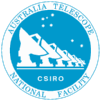| 17 | | The task to examine is {{{opcor}}. It's unclear how complex the frequency dependency is. |
| | 17 | The task to examine is {{{opcor}}}. It's unclear how complex the frequency dependency is. |
| | 18 | {{{ |
| | 19 | |
| | 20 | Subject: RE: opacity @7mm |
| | 21 | Date: Thu, 19 Apr 2007 15:06:23 +1000 |
| | 22 | From: Bob Sault <rsault@physics.unimelb.edu.au> |
| | 23 | Reply-To: <rsault@physics.unimelb.edu.au> |
| | 24 | To: <Ilana.Feain@CSIRO.AU> |
| | 25 | |
| | 26 | Well ... my guess (without having done any analysis to |
| | 27 | half convince myself!) is that 7mm opacity could |
| | 28 | be handled the same way as 12mm opacity. |
| | 29 | |
| | 30 | At the risk of repeating material you will know |
| | 31 | already - but just to make sure we are talking |
| | 32 | the same language ... |
| | 33 | |
| | 34 | For the 12mm system, you have a system temperature |
| | 35 | measurement from the noise diode. This is a system |
| | 36 | temperature at the feed horn, rather than an above |
| | 37 | atmosphere system temperature. As such, it corrects |
| | 38 | for the effects *except* for opacity. In Miriad |
| | 39 | ATLOD, the opacity is estimated using a model |
| | 40 | atmosphere. The inputs to the model are temperature, |
| | 41 | humidity and pressure. It includes propagation |
| | 42 | effect models which are a function of frequency and |
| | 43 | elevation. It assumes clear skies (no clouds). The model |
| | 44 | will be better than nothing, but it is still just |
| | 45 | a model, and it is trying to simplify a possibly |
| | 46 | complex atmosphere to a few parameters. |
| | 47 | |
| | 48 | However the calibrator and the program source will |
| | 49 | be in the same part of the sky: the opacity difference |
| | 50 | between program source and calibrator should be small |
| | 51 | to start with, and the residual difference should be |
| | 52 | smaller still after the opacity model correction. A |
| | 53 | bigger deal is the difference in the opacity from |
| | 54 | observations of the flux calibrator and the |
| | 55 | secondary calibrator. |
| | 56 | |
| | 57 | My guess is that you can do the same at 7mm as 12mm. |
| | 58 | I assume 7mm has a noise diode?? |
| | 59 | |
| | 60 | One problem with sky dips (which I took too long to |
| | 61 | appreciate) is that the antennas are only ~60% efficient. |
| | 62 | That means that effectively 40% of the collecting area is |
| | 63 | looking at other parts of the sky. Because the lower |
| | 64 | elevations in the beam are asymmetrically "hotter" than |
| | 65 | closer to the zenith, this biases sky dips, and they |
| | 66 | do not give the right results. I found, for example, |
| | 67 | that the inferred T_receiver was always poorer when |
| | 68 | the weather was poorer - which implies the deduced |
| | 69 | opacities were on the optimistic side (note T_receiver |
| | 70 | and T_sky should be independent). |
| | 71 | |
| | 72 | -- |
| | 73 | }}} |
